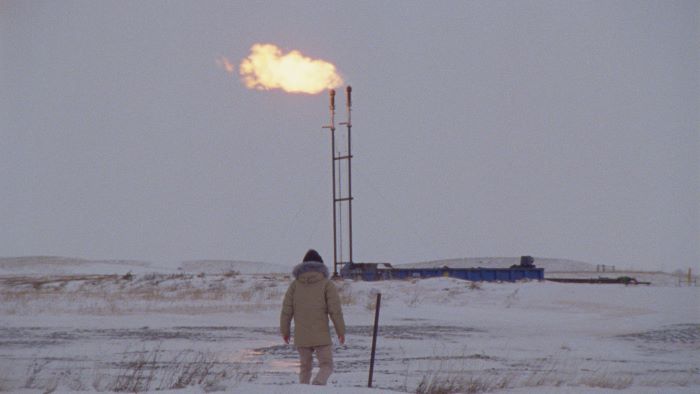From the outset, this looks like a movie that’s going to waste no time. In fact, it feels almost like an episode of 24. A young woman in a pink coat, Xochitl (Ariela Barer), walks down the street and slashes someone’s tires, then slaps a poster on the windshield, offering the driver instructions to discover why the property was vandalized. Soon, others are starting to hit the streets, all over the country, at a similarly breakneck pace. They go about their everyday business, then quickly cover their tracks and start to head out. Attending a support group, Theo (Sasha Lane) tries to act calm before she packs her things and leaves. Alisha (Jayme Lawson), a housecleaner, edits herself out of the home security camera footage before she tells a quick fib on the phone explaining her absence. All head to the same place in West Texas, where they assemble to blow up a pipeline in the name of environmental justice.
The film operates on two tracks. In one, the activists meticulously assemble their materials and execute their plan, often to a pounding techno score and with tense energy. On the other, the backstory of each character unfolds. Predictably, each has a different angle on the situation and a different reason to be present. More than a few saboteurs are Native Americans, and their anger is as much about forced displacement as it is about ecology. Others have had property taken from them or have leukemia from having grown up next to an oil plant or are, tenuously, being watched by the FBI. Xochitl is especially frustrated by a condescending peer at her college, who explains to her that incremental change is the best way forward. She drops out to dedicate herself to more radical action. While nominally all have assembled because they believe that sabotage is the only way forward in a world that refuses to act quickly enough on climate change, not everyone is completely at peace with this action, and each point of view is neatly expressed at some point or another.
There are two potent sequences. In one, Dwayne (Jake Weary), a Texan whose land has been seized by the oil companies, knocks a drone out of the sky. In another, Rowan (Kristine Froseth), a young punk, plies a bullet out of the arm of her boyfriend Logan (Lukas Gage) after they’ve escaped from the pipeline’s refinery guards. The scene woke me up and was a bit of a shock because, in spite of its brisk pace, this is a hard film to be invested in.
More than once, the college students are both complacent and obtuse, whereas the real radicals are the ones who drop out and blow things up. That’s an unwitting irony, because this film resembles nothing if not a half-baked college project. The characters’ backstories and the points of view they express are rendered so mechanically and written so shallowly that they seem like boxes being checked off for an assignment. In fact, more than once, the script comes across like a fairly civil Twitter discussion or a 90-minute exercise in exposition. Consequently, no one is especially revealing, and the action, even though it is performed at a breakneck speed, lacks drive and weight. Though it strives to be a wakeup call for those who want radical change to happen (and I’m not saying they shouldn’t), the movie feels tame and academic.
You’d think, given the high stakes the activists are up against, that the filmmakers would have at least treated us to a solid action movie. But, alas, apart from the two scenes mentioned above, the action is pretty tame too.







Leave A Comment